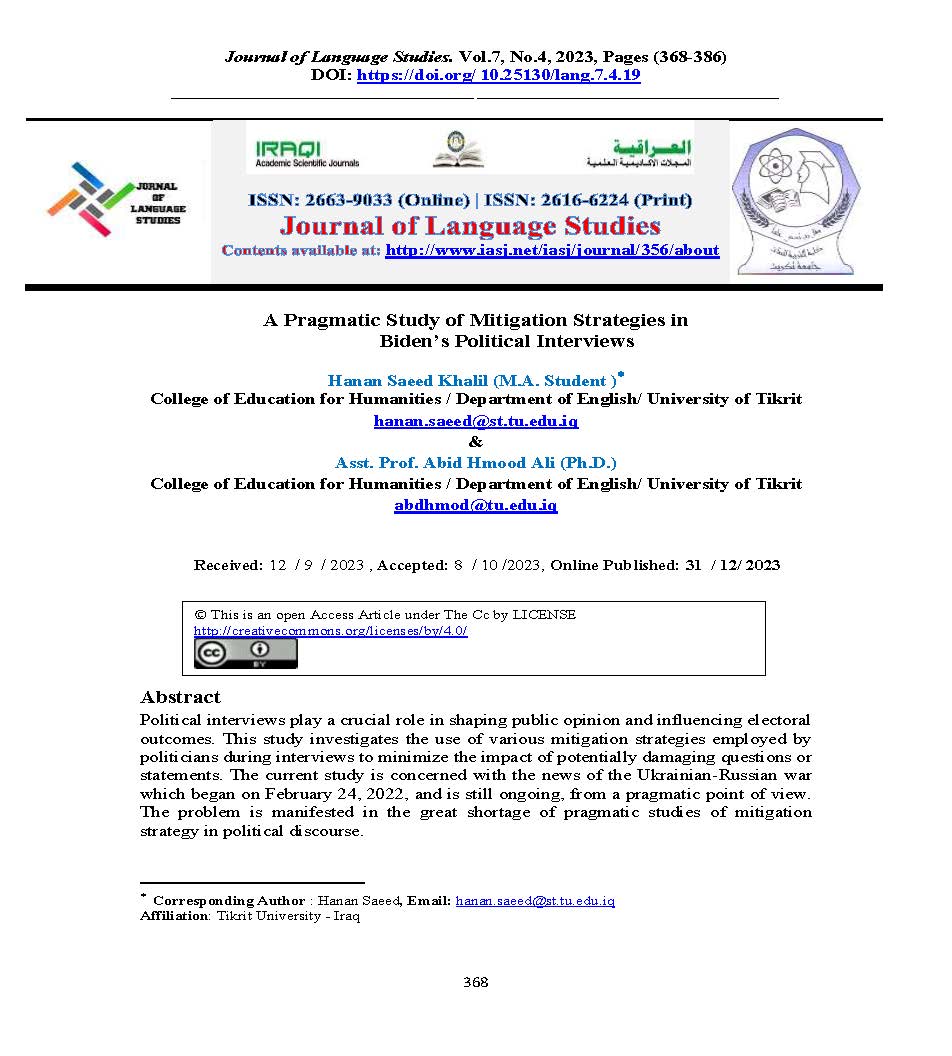A Pragmatic Study of Mitigation Strategies in Bidenʼs Political Interviews
Hanan Saeed Khalil
College of Education for Humanities / Department of English/ University of Tikrit
Abid Hmood Ali
College of Education for Humanities / Department of English/ University of Tikrit
DOI: https://doi.org/10.25130/lang.7.4.19
Keywords: Mitigating strategies, Political interviews, Biden, Ukraian-Russian War
Abstract
Political interviews play a crucial role in shaping public opinion and influencing electoral outcomes. This study investigates the use of various mitigation strategies employed by politicians during interviews to minimize the impact of potentially damaging questions or statements. The current study is concerned with the news of the Ukrainian-Russian war which began on February 24, 2022, and is still ongoing, from a pragmatic point of view. The problem is manifested in the great shortage of pragmatic studies of mitigation strategy in political discourse.
The present study adopts Caffi's (2007) model to analyze the selected data. The aspects of this model include five main types, which are: bushes, hedges, deictic shields, quotational shields, and topical shields. Each strategy differs from the other in composition. The deictic shields contain six sub-strategies and the topical shields contain two sub-strategies.
The study investigates mitigation strategies in one of Joe Bidenʼs , the current US president interviews . It aims to highlight the mitigation strategies used in Biden 's political interview. To investigate the most frequent type of mitigation strategies are used in the data under study.
To achieve the aims of the study and verify its hypotheses, the study hypothesizes that some mitigation strategies are used in Biden 's interview. The most commonly used strategy is the deictic shields strategy.
Qualitative and quantitative methods are used in analyzing data.The most important conclusions of the study are: 1)It is found that the mitigation strategies employed in Bidenʼs interview are : bushes ,hedges , deictic shields ,and topical shields and 2) the most commonly used strategy in Bidenʼs interview is deictic shields.
References
Caffi, C. (2007). Mitigation Amsterdam: Elsevier
Caffi, C. (1999). “On mitigation.” Journal of pragmatics, 31(7), 881-909.
Fraser, B.(1980). “Conversational mitigation.” Journal of pragmatics, 4(4), 341-350.
Holmes, J. (1984). “Modifying illocutionary Force.” Journal of pragmatics, 8(3), 345-365.
Gladwell, M. (2008). Most likely to succeed. The New Yorker, 15, 36-42.
Salih, A. I. A. a. S. M. (2020). “A Taxonomy of Mitigation Devices in English Language.” Koya University Journal of Humanities Social Sciences 3(1), 31-40.
Schneider, S. (2010). “Mitigation”. In (eds) Wolfram Bublitz, Andreas H . Jucker Klaus P. Schneider . Handbooks of pragmatics ,(6) 253-269
Vine, B. (2010). Interpersonal Issues in the workplace. In (eds)Miriam A. Locher , Sage A . Graham . Interpersonal pragmatics ,pp. 329-352, New York : De Gruyter Mouton.
Vlasyan, G. R., Pastukhova, O. D., & Shusharina, V. A. (2020). On Hedging And Mitigation In The Speeches Of Boris Johnson. European Proceedings of Social and Behavioural Sciences.

